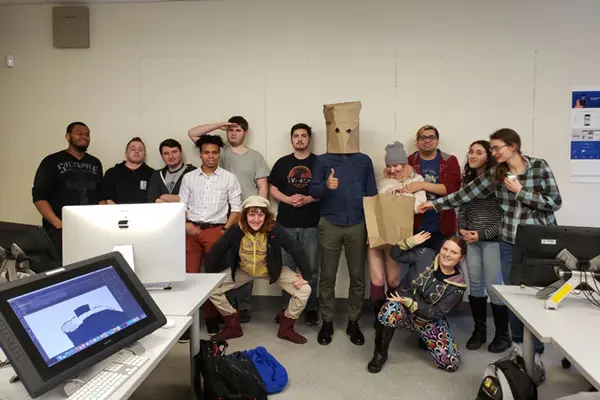‘Our Students are in the Right Place’

06/18/2020
By David Perry
For the first time, UMass Lowell’s animation program has cracked the top five among the state’s animation schools, ranking third in Massachusetts according to Animation Career Review’s 2020 listing.
It is good news for the university and the program’s students, says Pouya Afshar, the assistant professor of Art & Design who began developing the courses and degree pathways when he joined the College of Fine Arts, Humanities and Social Sciences in 2014.
“It means that our students are in the right place,” says Afshar, who adds that support from the administration allows faculty “to just focus on student success and happiness.”
“We are a growing school, and every year we improve our reputation because the work of our students is getting better and better,” he says. “I feel that our students love what they do. That’s what matters.”
“It’s phenomenal and unexpected for such a young and growing program,” says Art & Design Department Chair Ellen Wetmore. “I’m very proud of the teachers and students.”
In 2017, the program – a bachelor of fine arts in art with a concentration in animation and interactive media – was officially added. It has been overseen by a team of professors in addition to Afshar, including initially Jehanne-Marie Gavarini, and later joined by Misha Rabinovich and Yuko Oda.
For Jacqueline Gallant, heading into her senior year of studying animation, the state ranking is “quite impressive.”
UMass Lowell offers a wider breadth of study than art schools, she says.
“UML allows many of us an alternative to art school, so hearing that it’s equal to or better than most art programs makes me feel like we aren’t missing out.”
Gallant says she has “some of the most amazing professors,” is part of a “close-knit group of students” and is learning “a lot of practical skills.”
Gallant’s artwork has “drastically improved since I joined the program,” she says, “and I was able to obtain an internship with the work I’ve done here.”
She is working at Clambake Animations, a small studio in Watertown. She does “a little bit of everything, including character designs, visual development and some 3D modeling.”
Gallant says she eventually hopes to work on “concept art or visual development for game or animation studios, although I’m leaning toward games.”
Employers will be watching.
“Studios and media companies care about their employees’ education,” says Afshar. “They’re also starting to recognize what we do best and are coming after our students.
What do they do best? Train “hybrid artists,” says Afshar. Students are exposed to different fields of new media, sequential imagery and interactive media.
“Not many animation departments offer that,” he says. “Also, we are still a fine arts major rather than a film major, so our students get to learn about the foundations of art more meticulously compared to a purely film-based structure, which I think is a benefit.
“Many film schools fail to educate their students about the art movements, conceptual art and the history of art.” Those students and their work may serve the whims of Hollywood, but that “could be problematic for students in the long run because what they know could end up being outdated in time.”
Animation Career Review launched in 2011 to inform aspiring animation professionals of the college choices that may best suit their needs. The website is used by those interested in studying and establishing careers in graphic design, game design and digital art.
The site draws roughly 100,000 unique visitors a month, it claims.
Third place has UML in front of the School of the Museum of Fine Arts (SMFA) at Tufts University, in fourth place, and fifth-place finisher Northeastern University. The top spot went to the Massachusetts College of Art and Design and runner-up was Emerson College.
Ranking criteria includes academic reputation, admission selectivity, depth and breadth of the program faculty, value as related to tuition and indebtedness, graduation rate and employment data.




